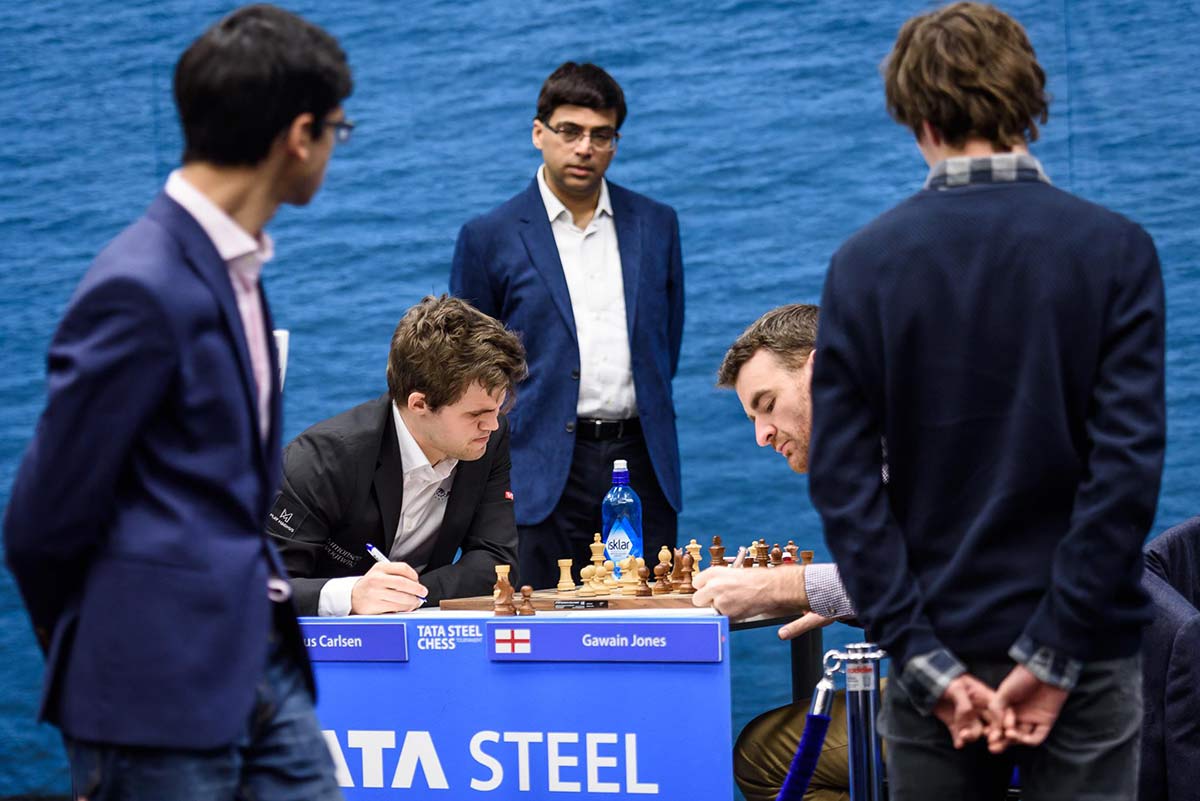


As I write these lines, Fabiano Caruana has come second in the U.S. Championship half a point behind Samuel Shankland who won the title. On the other hand, Carlsen scored first in Gashimov Memorial Tournament ahead of Ding Liren, Karjakin and others. The trial of strength for both players together was the Grenke international tournament that Fabiano won and Magnus fell behind, bogged down by draws. Coming as it did soon after his victory at the Berlin Candidates’ Tournament it raised the hopes of his fans that he would win the world championship this year. Those hopes still remain in spite of the little setback in the U.S. Championship. In fairness to Magnus, in the Wijk aan Zee Tournament held early this year it was he who dominated the event and it was Caruana who suffered. This issue of ChessBase includes all the games from the tournament and quite a few are annotated.
One game that fascinated chess fans was the Carlsen-Gawain Jones encounter. As is known, Magnus blundered a piece and still managed to win the game.

In this issue, it is annotated in detail by Peter Heine Nielsen, Carlsen’s second. I have cross-checked it with analysis of other experts, not to mention the comments by the players themselves after the game.
A performance that Emanuel Lasker and Viktor Korchnoi would have appreciated.
Magnus, however, was modest, said he was embarrassed, and subsequently wrote on his blog:
Next, I played Gawain Jones with the white pieces. As admitted in an interview immediately after the game Sunday, I disliked both the trend and frankly also my position, and in that situation discovering that I had blundered badly with 17.g4?? was partly a relief. It couldn’t get any worse, and despite the extra piece black does not have an obvious plan. Trying to exchange queens was a mistake and after g5! I was at least close to being back in the game. The position after Qa3 and b3 was fascinating and inspiring because it didn’t resemble anything I’ve seen before. Black is a piece up, white has no direct threats, but it is far from obvious that black is better. He continued to go astray and even material down it soon became apparent that I was winning.
Magnus has considerable experience of Dragon as he used to play it with Black himself until he switched to the more solid 1...e5. In the present case, he was also aware of Jones’ reputation as a Dragon expert. However, he was not expecting him to play it as the Englishman had also switched over to 1...e5 in recent years.
So what made him play the Dragon?
Peter Heine Nielsen comments, “A slight surprise as recently Jones have preferred the indeed more solid 1...e5. But as these days publicity is what matters even Nakamura played the Dragon in order just to get in one funny tweet, why wouldn't Jones use his opportunity at the stage vs. the World Champion to advertise his two books on the subject?”
Not really. The books in question were published way back in 2015 by Quality Chess. As an author, Gawain Jones himself would have had little to do with the publicity or marketing of his work..
It was Sue Jones, Gawain's wife who offered the background of the game:
Round 8 was a big game for Gawain, he was facing World Champion Magnus Carlsen for the 3rd time. This would be his second game against a reigning World Champion, having played Vishy at the London Chess Classic in 2012. Before the game, I asked Ga [sic] what would happen if Magnus played 1.e4 and if it would be a Dragon to which he replied “I don’t think he’ll allow the Dragon”. Lo and behold, when I was in the playing hall it became a Dragon. Ga had plenty of time and Magnus was having long thinks which made me wonder if he wasn’t expecting this. When I got back to the room. Magnus played 17.g4? which was a blunder. Fortunately for Magnus he had some compensation – strong knight, light squares and Gawain unfortunately quickly erred. It was interesting to see all the positives/negative comments online with people not understanding the difficulties that Black could have in the position. I asked GM Eric Hansen who joined us for dinner 'Do you think you would beat Stockfish from that position?' to which he replied an emphatic 'No!'. Just because the computer says it’s winning, doesn’t mean you’ll win the game. Playing a player like Magnus, who is the world’s best practical player in such a position, meant that it was never easy to win. There was a point in the game, after 22…Qb6, where I started to feel like things had gone wrong and then things went from bad to worse in a few more moves. I’m really proud of Gawain and after the game he was relatively cheerful, he even went to the commentary room to discuss his game.
After reading this account one cannot but feel sympathy for Gawain and also appreciate his sportsmanship.
To return to the game, it was first analysed by Golubev in the ChessBase round report. Peter Heine Nielsen takes it further supplementing it with analysis of his own. Both maintain, 14...Re8 followed by 15...f5 is playable and engines agree. In a recent game with Anand in Tal Memorial Blitz 2018 Nakamura opted for the direct 14...Rb8 and got no more than a draw (you would find it in this issue). So Gawain’s TN deserves a second look.
In the next part of the review, I shall deal with much else that is valuable in this issue.
Continued in part 2: "Why is Anish Giri on the cover?"...